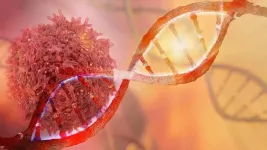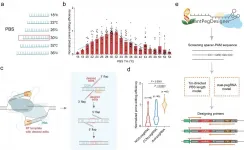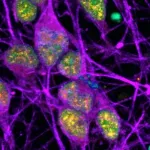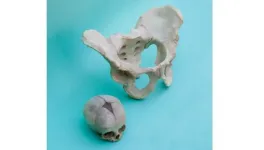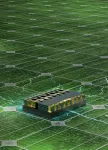(Press-News.org) LA JOLLA--The glow of a panther's eyes in the darkness. The zig-zagging of a shark's dorsal fin above the water.
Humans are always scanning the world for threats. We want the chance to react, to move, to call for help, before danger strikes. Our cells do the same thing.
The innate immune system is the body's early alert system. It scans cells constantly for signs that a pathogen or dangerous mutation could cause disease. And what does it like to look for? Misplaced genetic material.
The building blocks of DNA, called nucleic acids, are supposed to be hidden away in the cell nucleus. Diseases can change that. Viruses churn out genetic material in parts of the cell where it's not supposed to be. Cancer cells do too.
"Cancer cells harbor damaged DNA," says Sonia Sharma, Ph.D., an associate professor at the La Jolla Institute for Immunology (LJI). "Mislocated DNA or aberrant DNA is a danger signal to the cell. They tell the cell, 'There's a problem here.' It's like the first ringing of the alarm bell for the immune system."
Now Sharma and her colleagues have published a new Nature Immunology study describing the process that triggers this alert system directly inside tumor cells. Their research shows that a tumor-suppressor enzyme called DAPK3 is an essential component of a multi-protein system that senses misplaced genetic material in tumor cells, and slows tumor growth by activating the fierce-sounding STING pathway.
In the world of cancer immunotherapy, the STING pathway is well-known as a critical activator of cancer-killing T cells that kicks off the body's powerful adaptive immune response. The new study shows that through DAPK3 and STING, the tumor's own innate immune system plays a greater role in cancer immunity than previously appreciated.
"The tumor-intrinsic innate immune response plays an important role in natural tumor growth and cancer immunotherapy response," says Sharma.
Tumors evolve mutations in tumor-suppressor genes that allow them to grow faster than normal tissue. Discovery of the critical role that DAPK3 plays in the STING pathway highlights a distinct problem in cancer and cancer immunotherapy. Tumor cells can acquire mutations that allow them to evade the immune system by keeping cells from sensing red flags such as misplaced DNA.
Sharma and her colleagues with the LJI Center for Cancer Immunotherapy, Max-Planck Institute of Biochemistry and UC San Diego found that loss of DAPK3 expression or function in tumor cells severely hindered STING activation. Their research in mouse models shows that these tumors were hidden from the immune system, and the researchers observed very few cancer-targeting CD8+ "killer" T cells in DAPK3-deficient tumors. As a result, loss of DAPK3 in tumors decreased responsiveness to cancer immunotherapy.
"Tumors lacking DAPK3 grow faster in vivo because they evade the immune system. They are also resistant to certain immunotherapy regimens, including combination therapies using the immune checkpoint blocker anti-PD1 to target anti-tumor T cells," says Sharma.
Pharmaceutical companies are pursuing immunotherapies to activate STING, which are intended to be used in combination with immune checkpoint blockers. The new findings emphasize the importance of activating STING in tumor cells themselves--to properly set off that early alert system.
"Tumor-intrinsic immune responses are important," says study co-first author Mariko Takahashi, Ph.D., a former LJI postdoctoral associate who now serves at Massachusetts General Hospital Cancer Center.
The researchers are now looking for additional proteins that play a role in the early innate immune response to cancer. "There are many players in the tumor microenvironment," says Takahashi.
INFORMATION:
The study, "The tumor suppressor kinase DAPK3 drives tumor-intrinsic immunity through the STING-IFN-β pathway," was supported by the National Institutes of Health (grants R01CA199376, U01DE028227, U54CA260591, S10OD020025 and R01ES027595), a Cancer Research Institute Irvington Postdoc Fellowship and the National Institute of General Medical Sciences (grant T32 GM007752).
Additional study authors include co-first author Chan-Wang J. Lio, Anaamika Campeau, Martin Steger, Ferhat Ay, Matthias Mann, David J. Gonzalez and Mohit Jain.
DOI: 10.1038/s41590021-00896-3
About La Jolla Institute for Immunology
The La Jolla Institute for Immunology is dedicated to understanding the intricacies and power of the immune system so that we may apply that knowledge to promote human health and prevent a wide range of diseases. Since its founding in 1988 as an independent, nonprofit research organization, the Institute has made numerous advances leading toward its goal: life without disease.
New clues to a long-pursued drug target in cancer may reside within immune cells, researchers at the University of Michigan Rogel Cancer Center have discovered.
The findings, which appear in Nature Immunology, not only shed new light on cancer immunology, they also suggest clinical trials related to this key target -- an interaction that destabilizes the important p53 tumor suppressor protein -- may unnecessarily be excluding a large number of patients.
The researchers are optimistic that the findings could help make immunotherapy treatment more effective against ...
CORVALLIS, Ore. - Warm river habitats appear to play a larger than expected role supporting the survival of cold-water fish, such as salmon and trout, a new Oregon State University-led study published today found.
The research has important implications for fish conservation strategies. A common goal among scientists and policymakers is to identify and prioritize habitat for cold-water fish that remains suitably cool during the summer, especially as the climate warms.
This implicitly devalues areas that are seasonally warm, even if they are suitable for fish most of the year, said Jonny Armstrong, lead author of the paper and an ecologist at Oregon State. He called this a "potentially severe blind spot for climate change adaptation."
"Coldwater ...
Lithium-ion batteries have made possible the lightweight electronic devices whose portability we now take for granted, as well as the rapid expansion of electric vehicle production. But researchers around the world are continuing to push limits to achieve ever-greater energy densities -- the amount of energy that can be stored in a given mass of material -- in order to improve the performance of existing devices and potentially enable new applications such as long-range drones and robots.
One promising approach is the use of metal electrodes in place of the conventional graphite, with a higher charging ...
Many psychiatric disorders have genetic causes, but the exact mechanism of how genes influence higher brain function remains a mystery. A new study provides a map linking the genetic signature of functions across the human brain, a tool that may provide new targets for future treatments.
Led by Bratislav Misic, a researcher at The Neuro (Montreal Neurological Institute-Hospital) of McGill University, a group of scientists performed machine learning analysis of two Open Science datasets: the gene expression atlas from the Allen Human Brain Atlas and the functional ...
DURHAM, N.C. - Engineers at Duke University have developed an electronics-free, entirely soft robot shaped like a dragonfly that can skim across water and react to environmental conditions such as pH, temperature or the presence of oil. The proof-of-principle demonstration could be the precursor to more advanced, autonomous, long-range environmental sentinels for monitoring a wide range of potential telltale signs of problems.
The soft robot is described online March 25 in the journal Advanced Intelligent Systems.
Soft robots are a growing trend in the industry due to their versatility. Soft parts can handle delicate objects such as biological tissues that metal or ceramic components would damage. Soft bodies can help robots float or squeeze into tight spaces where rigid ...
Lincoln, Neb., March 25, 2021 -- Palm oil, the most important source of vegetable oil in the world, is derived from the fruit of perennial palm trees, which are farmed year-round in mostly tropical areas. The palm fruit is harvested manually every 10 days to two weeks, then transported to a mill for processing, and ultimately exported and made into a dizzying array of products from food to toiletries to biodiesel.
"You probably ate palm oil for breakfast," said Patricio Grassini, an associate professor of agronomy at the University of Nebraska-Lincoln. "There is probably palm oil in your ...
Precision genome editing enables the precise modification of DNA in living cells, thus enabling a breadth of opportunities for plant breeding. Prime editors, developed by Prof. David R. Liu and his colleagues, permit the installation of desired edits in a programmable target site. They are comprised of an engineered Cas9 nickase (H840A)-reverse transcriptase (RT) fusion protein and a prime editing guide RNA (pegRNA).
Prime editors were previously developed and optimized as an extremely versatile editing strategy for generating programmable point mutations, insertions and deletions in rice and wheat by Prof. GAO Caixia of the Institute of Genetics and Developmental Biology (IGDB) of the Chinese Academy of Sciences ...
Researchers at the National Institutes of Health (NIH) have discovered specific regions within the DNA of neurons that accumulate a certain type of damage (called single-strand breaks or SSBs). This accumulation of SSBs appears to be unique to neurons, and it challenges what is generally understood about the cause of DNA damage and its potential implications in neurodegenerative diseases.
Because neurons require considerable amounts of oxygen to function properly, they are exposed to high levels of free radicals--toxic compounds that can damage DNA within cells. ...
Fossil remains of the human pelvis are rare because the pelvic bones do not preserve very well. Therefore, it has remained unclear when human sex differences in the pelvis evolved: jointly with upright walking, or later, together with the large human brains. "We have discovered that the pattern of sex differences in the human pelvis is probably much older than previously thought", says evolutionary biologist Barbara Fischer.
A team of biologists from the University of Vienna, the KLI for Evolution and Cognition Research, and the University of Calgary compared pelvic sex differences in humans with those in chimpanzees, the most closely-related living species to modern ...
Power converters are the little-known systems that make electricity so magical. They are what allow us to plug in our computers, lamps and televisions and turn them on in a snap. Converters transform the alternating current (AC) that comes out of wall sockets into the exact level of direct current (DC) that our electronics need. But they also tend to lose, in average, up to 20% of their energy in the process.
Power converters work by using power transistors - tiny semiconductor components designed to switch on and off and withstand high voltages. Designing novel power transistors to improve the converters' efficiency is the aim of the team of EPFL engineers. With their entirely new transistor design, based on the counterintuitive application ...
